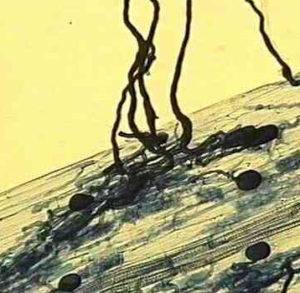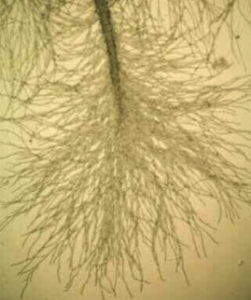Mycorrhizal Fungi FAQ
What is Mycorrhizal Fungi?
 Mycorrhizae are naturally occurring soil fungi that have been essential to plant life for eons. These fungi penetrate the root system upon germination, colonize, and reproduce themselves within the root. The Mycorrhizae then produce hyphae, which grow off the root system at a rapid rate, to gather the nutrients and water that the plant is calling for. They can increase your root’s effective surface area by 50-250 times. They will continue to grow the life cycle of the plant and form a symbiotic relationship with your crops. Through photosynthesis, the plant will send down starches and sugars to keep them growing and supply the plant with the nutrients and water it needs to survive and reach maximum size.
Mycorrhizae are naturally occurring soil fungi that have been essential to plant life for eons. These fungi penetrate the root system upon germination, colonize, and reproduce themselves within the root. The Mycorrhizae then produce hyphae, which grow off the root system at a rapid rate, to gather the nutrients and water that the plant is calling for. They can increase your root’s effective surface area by 50-250 times. They will continue to grow the life cycle of the plant and form a symbiotic relationship with your crops. Through photosynthesis, the plant will send down starches and sugars to keep them growing and supply the plant with the nutrients and water it needs to survive and reach maximum size.
What does Mycorrhizal Fungi do?

Mycorrhizal Fungi perform various tasks within the soil’s and plant’s life cycle. There are billions of tiny micro-organisms within our soils that break down organic matter and create a form that the plant can use (they basically eat organic matter and poop). The excretions from these organisms are now in a usable form for your plant. The main job of the mycorrhizal hyphae is to find those excretions (natural fertilizer) and take the nutrients back to the plant. Many farmers are now reducing fertilizer costs by 30+% because if this “natural fertilizer” their plants can now access.
Mycorrhizae are also powerful breakers of chemical tie-ups in our soil. The hyphae of the mycorrhizae have the ability to release powerful enzymes that can unlock and bring only the nutrients the plant is calling for back to the plant (mainly phosphorus tie-ups). The mycorrhizae hyphae have a PSI of 1000 while a normal root only has a PSI of 200-300. This means that your plant will get nutrients from places your roots can’t go. With this strong PSI, the hyphae will open up pores in your soil for better water filtration as well as prevent leaching of nutrients.
Mycorrhizal Fungi protects your root system from root rot by forming a protective barrier around your root system. They will also protect your roots from pests such as cyst nematode. Mycorrhizal Fungi will hold the (cyst) in place and release enzymes killing them. Then, they’ll use them as a food source feeding the mother plant. This all happens naturally because the plant and root are feeding the mycorrhizae hyphae, and if the root dies, the hyphae die. It’s the kill or be killed law of nature. If you have a cyst problem and are using a nemacide to control them…how many good nematodes are you killing? There billions more good nematodes in our fields than there are cyst. Let’s just kill the cyst and leave to good nematodes to break down organic matter and feed our plants.
Most soils that we do a PLFA test on are 90-95% bacteria. There is supposed to be balanced (50/50) ratio between bacteria and fungi but through tillage, anhydrous, fumigation, and other harmful practices we have killed the fungi and left our soils dependent upon synthetic fertilizers to make our plants grow. UV light kills fungi so tillage practices have killed off any remaining Arbuscular Mycorrhizal Fungi.
Does Mycorrhizal Fungi work on all crops?

No! There are many thousand different species of Mycorrhizae. Through research and development, we have selected the best species for the crops we grow. Certain plants are non-mycorrhizal, which means they cannot use these spores to boost their root system. Crops that are in the brassica family are non-mycorrhizal (i.e. Sugar Beets, Canola, Mustard, etc.). Most weeds we have issues with (Palmer Amaranth, Waterhemp, Ragweed, and Kochia to name a few) are also non-mycorrhizal. Through our years of research and testing, we can safely say that we cannot reduce the number of weeds in a particular field; However, mycorrhizae can reduce the vigor of those weeds by starving them of nutrients and water.
What are the best crops or best fields to put Mycorrhizae on?

The ones that make you the most money! Ultimately, it comes down to Return on Investment (ROI). We urge farms to try it on several different crops and soil types, if not all of them, during the first year so we can determine which one has the biggest ROI. Doing this helps us formulate a plan for the years going forward. In the long run, we look to increase soil health and the B:F balance thereby increasing the soil’s ability to bring in more natural fertilizers which will decrease the inputs(Synthetic Fert Costs) making the farm more profitable!
We have several farms that now put Mycorrhizae on one particular crop each year. As that crop rotates fields per year, they are spreading the beneficial Mycorrhizal Fungi over the whole farm. Lighter, more drought-susceptible acres are the ones we would target first. The expanded root system that mycorrhizae produce will give your plants far better nutrient and water uptake, maximizing your yield for those acres. We see a far greater increase in yields on those acres than we do on heavier soils or irrigated acres. The end goal is to increase soil health and sustainability. With that comes the increased yields.
Where do I get Mycorrhizal Fungi, and which formulation should I get?
You can get it right here! We urge you to call and talk to one of our experts to ensure you are getting the correct formulation and using the correct dosage to get the best ROI.
We are the experts in Mycorrhizal Fungi. We’ve studied and tested several other mycorrhizal products on the market. We only carry the best products, so our farmers are getting what works and not a cheap copycat product. Our New MycoMaxx formulation is an 8 specie combination that has the highest spore count and is the most effective Mycorrhizal product in the world. We have interest from all over the world for our new product. We are excited to have it available for our farmers here in America. We will continue to monitor new sciences and test new mycorrhizal products and species as they emerge. This is a new age of farming, and we are here to help. We are always a phone call away with any questions you may have. We help farmers nationwide to ensure that they are here for generations to come.
